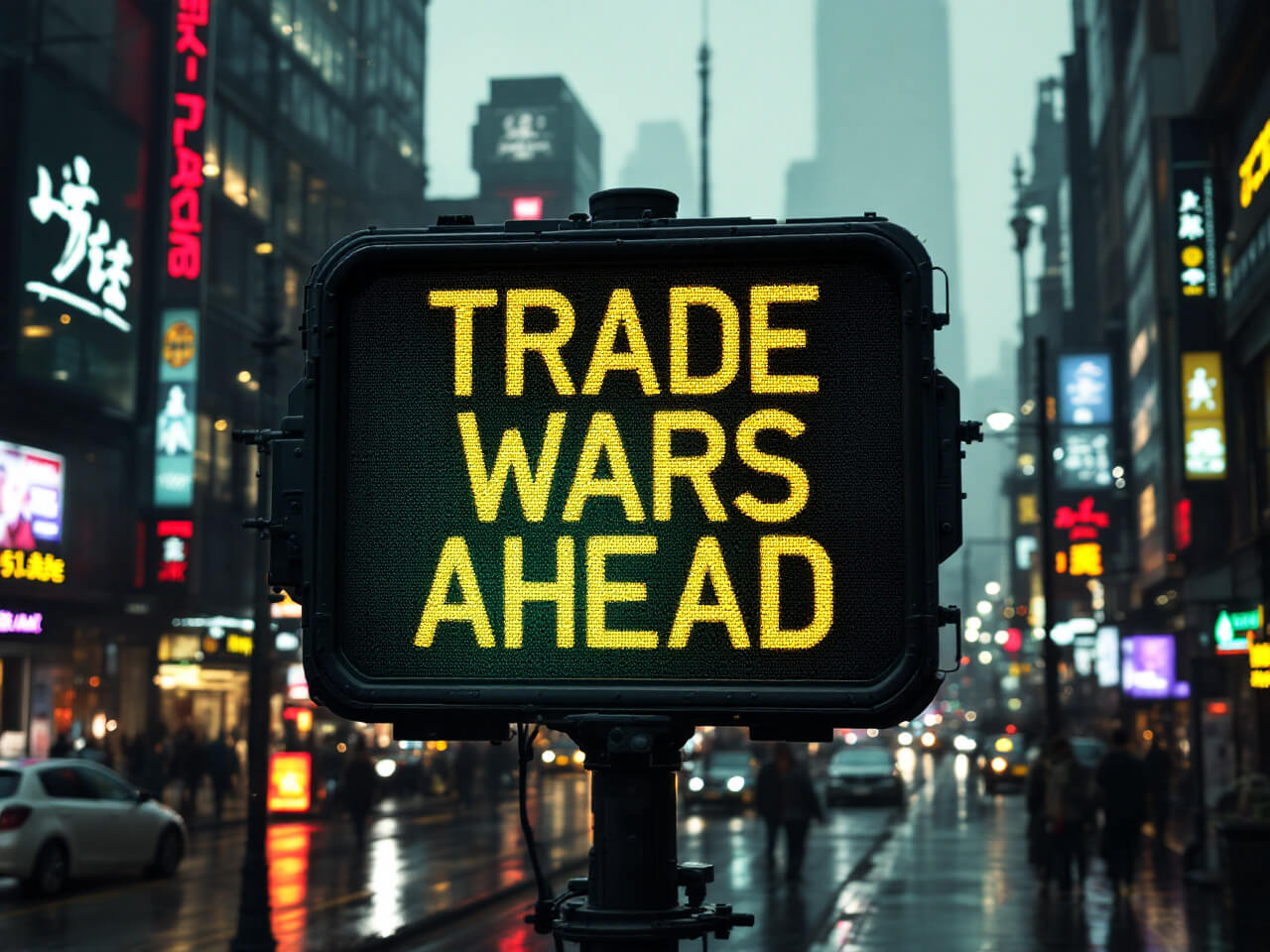
A renewed U.S.-led trade war under a potential Trump administration threatens not only global supply chains and economies, but also the personal realms of dating and marriage. Higher tariffs and retaliations can raise consumer prices and suppress employment, leaving singles and couples with tighter budgets and greater uncertainty. Tariff escalation leads to higher prices, reduced competitiveness, and fragmented supply chains – for example, initial U.S. tariffs in 2025 are estimated to raise domestic prices by ~2.7% and cut real GDP per capita by nearly 1% . Such economic strains trickle down to young adults’ social lives, affecting how they date, form relationships, and plan for family life. Meanwhile, rising geopolitical tensions and nationalism influence personal preferences and cross-border relationships. The sections below analyze these impacts in the United States, United Kingdom, European Union, and China, followed by a global synthesis.
A container ship unloading at the Port of Baltimore, USA. Trade wars disrupt global shipping and raise costs for businesses and consumers . Tighter budgets and economic uncertainty can have ripple effects on personal spending and life decisions, including dating and marriage.
United States
In the U.S., an escalated trade war would affect the dating landscape and marriage trends through multiple channels:
• Economic Strain on Singles and Couples: Tariffs function like a tax on consumers. Americans would face higher costs on everyday goods (researchers estimated a $3,000 increase in average new car prices from prior Trump-era tariffs ). Such inflation, combined with potential job losses in export-dependent industries, reduces discretionary income for leisure and dating. People may cut back on dating expenses during an economic downturn , opting for cheaper activities or postponing dates. Financial stress is also a well-known catalyst for relationship tension . Notably, economic uncertainty has already led many Americans to delay marriage for financial reasons . One 2019 survey found 26% of millennials postponed marriage due to money concerns (versus 8% of boomers) , and similar patterns are likely to intensify if living costs rise and job prospects waver.
• Impacts on the Dating Industry: The online dating sector could see shifts in user behavior and business performance. During periods of financial insecurity, people are less inclined to pay for premium dating app features or subscriptions. Indeed, the largest dating app company, Match Group, has reported a decline in paying users for several consecutive quarters leading into 2024 . A prolonged trade war downturn could further this trend as users trim non-essential spending. Additionally, techno-nationalism may force changes in dating platforms operating internationally. Under the previous administration, U.S. authorities raised national security alarms over Chinese ownership of popular apps – famously forcing a Chinese firm to divest from Grindr in 2020 due to fears Beijing could exploit Americans’ personal data . In a renewed climate of suspicion, foreign-based dating apps might face bans or trust issues, fragmenting the global user base. U.S. dating companies may likewise find overseas expansion harder if other nations retaliate with their own tech restrictions.
• Cross-Border Romance and Immigration Barriers: International relationships would face headwinds from stricter immigration and travel policies. A second Trump term is expected to reinstate and expand travel bans and rigorous vetting for foreigners , and potentially re-suspend certain work visas . Even family-based immigration could become more arduous – for instance, fiancé visas (K-1) might see “further restrict[ions] or scrutin[y]” leading to slower processing . This means American citizens trying to bring foreign partners to the U.S. could encounter long delays or denials. Many bi-national couples might simply choose to stay apart or settle outside the U.S. rather than face the red tape. Travel itself could be discouraged: one analysis projects that under an expanded trade war, international visits to the U.S. in 2025 would decline by ~12.7% as strained relations and a strong dollar dampen inbound travel demand . Fewer foreign students, tourists, and professionals coming to the U.S. translates into fewer chances for Americans to meet and date people from abroad. Even those already in cross-border relationships may struggle with visa uncertainty. (During the last U.S.-China standoff, one American-Chinese couple put wedding plans on hold, fearing it would be “much more difficult… to get a visa” or a job in the U.S. .) In short, love across borders could become a casualty of protectionism.
• Cultural Polarization and Dating Preferences: The tumult of a Trump-era trade war would likely amplify political and cultural polarization within the U.S., and this extends to dating. Surveys show Americans have grown less willing to date someone with opposing political views. About two-thirds of liberal and conservative singles say they’d reject a match who doesn’t share their politics . A combative national atmosphere (“America First” vs. globalists, etc.) may harden such attitudes, making the dating pool even more siloed. Furthermore, a surge in nationalism or even anti-China sentiment (as rhetoric blames China for trade imbalances) could affect interpersonal attraction. Anecdotally, people might become reluctant to pursue relationships that don’t align with their family or peer-group’s nationalistic expectations. On the positive side, couples that weather political differences often learn to communicate better, but overall the “deepening political divide” is bad news for marriage prospects as it adds yet another requirement (political compatibility) to finding a partner. This polarization, combined with the financial factors above, suggests U.S. marriage rates could continue to fall or marriage ages rise during 2025–26. (U.S. marriage age was already at a record high, and marriage rates had been “falling fast” in recent years .) Many young adults will feel they must be financially and ideologically “secure” before tying the knot, a threshold harder to meet in volatile times.
United Kingdom
As a close ally of the U.S., the UK would not be immune to the fallout of U.S.-led trade wars. Although Britain might seek to capitalize on trade diversion (negotiating its own deals amid U.S.–EU tariff fights), the overall effect on its dating and family trends is expected to be negative due to economic and social pressures:
• Cost of Living Squeeze and Family Formation: The UK is already grappling with a cost-of-living crisis, and a global trade war could aggravate inflation (via pricier imports) and dampen growth. Higher costs for fuel, food, and consumer goods leave young people with less disposable income for dating. A dinner date, wedding savings, or starting a household all become more challenging when wages don’t keep up with prices. British social commentators have noted that marriage now often seems “beyond reach for younger people already struggling with rent and rising living costs” . In fact, marriage rates in the UK have been on a long decline, hitting record lows in recent years. The 2021 census showed a huge increase in never-married 25–35 year-olds compared to a decade prior . Economic insecurity is a key driver – many postpone marriage until they feel financially secure. Trade war repercussions (like job uncertainty in manufacturing or exports) would reinforce this hesitation. We may see more couples cohabiting without marriage or moving back in with parents to save money, continuing trends already visible in Britain.
• Employment Prospects and Dating Confidence: Employment opportunities, especially for young adults, could be curtailed if a tariff war drags down UK exporters or leads to broader recession in Europe. For instance, if U.S. tariffs hit UK-linked industries (like auto manufacturing or aerospace supply chains), layoffs or hiring freezes could occur. Historically, spikes in unemployment correlate with declines in marriage and birth rates, as people lack confidence in providing for a family. Conversely, if the UK gains some short-term export advantage (e.g. selling into the U.S. market while EU goods face tariffs ), those benefits might not be widespread enough to boost average incomes significantly. Overall, many British singles might prioritize career recovery over romance in the mid-2020s. Those in relationships could delay engagements until the economy stabilizes. Financial readiness remains a strong prerequisite for marriage in the UK, much as in the U.S., and uncertainty in one’s job or income is likely to delay proposals and wedding plans.
• Immigration and International Dating: Post-Brexit Britain already has tighter immigration controls, and aligning with a hardline U.S. stance might further limit migration flows. Any additional visa hurdles for Europeans, Americans, or Chinese (for example, in a tit-for-tat diplomatic spat) would reduce cross-cultural mingling. The UK has a sizable international student population and global city (London) dating scene. If global mobility decreases – say Chinese students choose other countries due to U.S.–UK–China tensions – the diversity of dating options shrinks. British nationals in cross-border relationships might face difficulties similar to Americans (visa waits, greater scrutiny). However, one unique aspect is that UK citizens could somewhat benefit from U.S.–EU trade friction: the Aston Business School model suggested the UK might see “modest trade diversion benefits” when the US and EU impose tariffs on each other . This might translate into slightly better economic outcomes for the UK than the EU, potentially mitigating extreme economic distress. Still, any global slowdown will affect Britain too. The net effect on the dating scene is likely fewer Europeans on working holidays or work visas in the UK and fewer Britons working in EU countries – meaning fewer cross-channel romances. Domestic British dating preferences may also tilt inward: after years of nationalist rhetoric (Brexit, etc.), a trade war era could amplify “us vs. them” sentiments, though the UK is historically quite open in terms of marriages with different nationalities (especially within its multicultural population).
• Marriage Trends and Cultural Shifts: Culturally, the UK has become more accepting of delayed marriage and long-term cohabitation. A turbulent economy would reinforce this norm. Family law experts project further declines in marriage rates – an estimated 28% drop by 2050 in the UK (relative to past decades) if current trends continue . Trade wars by themselves won’t cause or halt this, but by potentially undermining economic confidence, they contribute to the same outcome: couples marrying later, if at all. We might also see smaller, cheaper weddings during 2025–26 as couples economize (the average UK wedding cost jumped to £20,700 in 2023 , and a recession could force that down with more registry office weddings or postponements). In sum, the UK’s “relationship economy” would likely retrench – with dating becoming more frugal and pragmatic, and marriages happening only once couples feel financially buffered against the uncertain future.
European Union
A U.S.-led tariff war would strain the European Union’s economies and could further alter the social fabric of relationships across member states. Key anticipated impacts in the EU include:
• Economic Uncertainty and Youth Prospects: Europe’s economic growth might falter under a trade war, especially if the U.S. imposes 25% tariffs on EU goods, leading to a “sharp transatlantic trade contraction” and production disruptions in Europe . Certain industries like Germany’s auto manufacturing or France’s aerospace could see reduced U.S. orders, prompting cutbacks. This is troubling for young Europeans, many of whom already face high youth unemployment (e.g. Southern Europe). Extended unemployment or gig instability makes it harder for young adults to date confidently or form independent households. Southern Europe is a cautionary tale: there, marriage rates have fallen sharply in recent decades, and much of the region’s low birth rate is attributed to this decline in marriage . One major reason is adverse economic conditions – many young Europeans are stuck living with parents into their 30s and lack stable jobs, which lowers their “family ambitions” . A protracted trade war recession would risk spreading such conditions more broadly across Europe. In practical terms, more European couples might postpone marriage until their thirties or beyond, and some may forgo having children due to financial insecurity. The age at first marriage and first childbirth, already among the highest in the world in countries like Italy and Spain, could climb even higher as people wait out the lean times.
• Cross-Border Relationships and Mobility in Europe: Within the EU, freedom of movement allows dating across national lines (e.g. a French-Spanish couple can live and work together easily). These intra-Europe relationships should remain unaffected by U.S. trade policies directly. However, if the U.S. trade war contributes to political rifts (say, the U.S. pressures Europe to “choose sides” against China, causing internal EU disagreements), there could be a rise in nationalist politics in Europe too. Populist or nationalist sentiments in various EU countries might discourage acceptance of immigrants or foreigners, subtly impacting interpersonal relations. For example, anti-immigrant rhetoric could make international couples feel less welcome. Additionally, travel between Europe and the U.S./China might decrease due to poorer diplomatic climate or higher costs (air travel could become more expensive with fuel price volatility and weaker currencies). Fewer Americans and Chinese traveling to Europe means fewer chances for Europeans to meet them romantically. Transatlantic relationships may suffer from any new visa rules or simply mutual distrust if, for instance, EU-U.S. negotiations sour. (The EU has already warned it “will retaliate if necessary” to U.S. tariffs , showing a potential for diplomatic strain.) In summary, while intra-European dating will mostly continue uninhibited legally, the overall pool of international encounters could shrink, and some Europeans may become more insular in partner choice under the influence of growing nationalistic narratives.
• Digital Platforms and Data Privacy: European tech companies and regulators will navigate the dating app industry carefully amid global trade tensions. The EU is known for strong data protection (GDPR), and if U.S.–China tech decoupling accelerates, Europe might also heighten scrutiny of dating apps for security. Chinese-owned apps are not major players in Europe’s dating market (which is dominated by U.S. and European services), but any that do operate could face pressure. Likewise, American dating companies operating in Europe might have to localize data storage or comply with ever-stricter privacy laws, as transatlantic trust on data flows erodes in a trade war environment. European users could also become wary of U.S. apps if the narrative of “digital sovereignty” gains traction. This could benefit European-grown dating services or even lead to government discussions about regulating algorithms and foreign influence in matchmaking platforms. While these are subtle effects, they form part of the “relationship economy” in that they shape which platforms people use to meet partners. If U.S. policies indirectly fracture the global internet, Europeans might find their dating app options more limited by region.
• Marriage Rates and Family Planning: Europe’s marriage and birth trends have been sliding for decades due to a mix of economic and cultural factors. A trade war’s chief influence would be economic – potentially tipping Europe toward recession and thereby discouraging family formation. We might see a repeat of patterns from past crises: after the 2008 Eurozone crisis, many countries saw record-low fertility and delayed marriage as austerity and unemployment hit. Conversely, if EU governments respond to the trade war with strong social support (e.g. unemployment benefits, stimulus), they might cushion the blow for young families. Some countries like France have historically managed to keep higher birth rates thanks to generous family policies . In 2025–26, those policies will be tested. Overall, it is likely that marriage will continue to become less common across the EU , with more couples opting for cohabitation. The perception of marriage as a financial and social milestone may further weaken if people feel achieving the requisite stability is too difficult amid global economic turmoil. On the extreme end, one could imagine a rise in “commuter couples” or long-distance relationships if job opportunities force partners to different countries (a scenario not uncommon in Europe). In short, Europe’s varied cultures share a common challenge: ensuring young adults feel secure enough to commit to long-term relationships and family life. A prolonged trade war would make that challenge harder, likely resulting in even later marriages and fewer children than already projected.
China
China, as a primary target of U.S. trade wars, would experience significant economic and social reverberations that extend into the domains of dating and marriage:
• Economic Pressures on Young Adults: Tariffs and decoupling efforts could slow China’s manufacturing sector and export-driven growth. This comes at a time when Chinese youth are already facing an employment crisis – urban unemployment for ages 16–24 hit a record 21.3% in June 2023 before officials stopped publishing the statistic. If U.S. tariffs further weaken export industries or foreign firms relocate out of China, job prospects for young Chinese (especially fresh graduates) may remain bleak. Economic stress is a top reason cited by Chinese millennials for delaying marriage. In 2024, marriages in China plunged by 20% to an all-time low , continuing a decade-long slide. Social media in China was abuzz with commentary that “people don’t want to get married, but that they can’t afford to get married!” . This captures how high housing costs, education expenses, and now job insecurity discourage nuptials. A trade war exacerbates the “can’t afford” syndrome: higher costs for imported goods (electronics, food, etc.) and potential inflation would squeeze young people’s budgets further. Even dating can be expensive in urban China – costs of dinners, gifts, and appearances add up. We may see more young Chinese turning to frugal dating practices or embracing trends like “lying flat” (choosing minimalism over career hustle) which also correlate with less emphasis on marriage. The government’s efforts to encourage early marriage and childbirth are likely to falter if the economic outlook remains uncertain for the youth. In essence, trade war headwinds could reinforce China’s current trend of later or fewer marriages and extremely low birth rates.
• Nationalism and Dating Preferences: U.S.-China tensions fuel nationalism within China, which can impact personal relationships and attitudes toward foreign partners. Chinese state media and online discourse often respond to trade war aggression with patriotic messaging. This might increase skepticism or hostility toward Americans (and possibly other Westerners) at the societal level. While many Chinese have dated and married foreigners, in recent years there have been instances of nationalist backlash against interracial couples (particularly when highly publicized on social media). Under a trade war climate, a segment of Chinese netizens might view dating or marrying a Westerner as unpatriotic. It’s important not to over-generalize – large cosmopolitan cities like Shanghai or Beijing have international communities where dating across cultures is common. However, the cultural polarization could grow. The U.S. has already taken extreme steps indicating mistrust, for example implementing a “non-fraternization” ban that forbids American diplomats in China from any romantic or sexual relationships with Chinese citizens (a policy unprecedented since the Cold War) . Chinese authorities likewise scrutinize foreign influence; they could enforce tighter monitoring of social interactions between locals and foreigners (under the guise of anti-espionage or COVID measures, for instance). All of this may create an atmosphere where cross-national couples feel pressure. A Chinese person might worry that dating an American could invite suspicion, and an American in China might hesitate to pursue romance due to such rules. On the other hand, heightened nationalism often goes hand-in-hand with a surge in traditional values. The Chinese government might intensify propaganda urging young people to marry fellow Chinese and start families as a patriotic duty to counteract demographic decline. Such campaigns were already underway, but their resonance could increase if framed as standing strong amid Western “economic aggression.” The net effect is likely fewer China-U.S. romances and perhaps a reinforcement of domestic pairings.
• Tech Decoupling and Dating Apps: China’s internet ecosystem is largely walled off from U.S. apps, and a trade war will keep it that way or tighten the wall. Popular Chinese dating apps (Tantan, Momo, etc.) serve the domestic market, while Western apps like Tinder or Bumble have very limited presence due to China’s firewall and regulations. In a scenario of escalating tech hostilities, China may double-down on data localization and censoring foreign platforms. For Chinese users, this means their online dating will continue to be on domestic platforms that operate under government oversight (which can censor topics and enforce real-name registration). Internationally, Chinese tech companies might scale back ambitions; for example, if a Chinese dating app planned to expand abroad, it might hold off to avoid political backlash. Likewise, any Chinese dating platforms still accessible outside (perhaps niche ones among diaspora) could be targeted by U.S. or European regulators. Essentially, the trade war accelerates the splintering of the digital space – Chinese looking to date foreigners online will likely have to use separate apps (or VPNs) not integrated with the rest of the world’s user base. Global matchmaking companies will treat China and the West as distinct markets. Additionally, communication tools vital to international couples, like WeChat, could face sanctions (the Trump administration previously attempted to ban WeChat in the U.S.). Losing access to communication platforms would be devastating for cross-border relationships. Thus, the tech decoupling threatens to not only isolate dating pools but also make it logistically harder for existing international couples to maintain close contact.
• Marriage and Family Trends: Even before any new trade war, China is in the midst of a marriage crisis. The average age of marriage has climbed, marriage rates hit their lowest since records began in 1986 , and 2023 saw more than half of 25–29 year-olds unmarried – a radical shift from just a generation ago. The government is alarmed because marriages are tightly linked to childbearing in China (culturally, having children out of wedlock is rare). The demographic implications are serious: a shrinking workforce and rapidly aging society. In response, policies like local incentives for marriage, matchmaking events, and propaganda against “leftover” singles have been rolled out. However, the fundamental blockers for young Chinese are economic and social: high expectations (one often “needs” a house, car, and steady income to be deemed marriageable, especially for men) and a desire for personal freedom. A trade war likely makes those economic expectations harder to meet – e.g. if export industries slump, men in factory towns might not attain the earnings to afford marriage. It could also indirectly inflate the brideprice or wedding costs in some regions, as families feel economic strain and demand more financial security in marriage arrangements. On the social side, international tension might reduce the number of Chinese studying or working abroad, which could slightly reduce the incidence of Chinese marrying foreigners, but those numbers were relatively small anyway. We might actually see a minor uptick in marriages of convenience if immigration rules tighten – for instance, some couples may rush to marry sooner if it’s the only way to stay together in one country before rules change (though in the U.S.-China context, such marriages would face heavy scrutiny under stricter visa vetting). In summary, China’s marriage rate is expected to remain low or decline further through 2025–26, with trade war-induced economic unease reinforcing young people’s decisions to postpone or avoid marriage. The government’s pro-marriage drive will be fighting against an unfavorable economic current.
A couple in traditional attire during a pre-wedding photo shoot in Beijing (February 2025). China’s marriage rate has plunged to the lowest level on record, dropping from 13 million marriages in 2013 to just about 6 million in 2024 . Many youths cite financial insecurity—“they can’t afford to get married”* —as a primary reason for delaying or forgoing marriage.*
Global Synthesis and Outlook
Across all these regions, a common theme emerges: economic anxiety and geopolitical tensions are inimical to the “relationship economy.” When people feel less secure – financially or in terms of world stability – they tend to retreat in their personal lives. Discretionary activities like dating suffer as wallets tighten, and major life decisions like marriage or having children get postponed. We saw this globally during the COVID-19 pandemic and in past recessions, and a trade war could have a similar if more gradual effect. In 2023, financial uncertainty was already causing many to delay marriage ; a tariff-induced downturn in 2025 could amplify that trend in the U.S., Europe, and China alike.
Another universal impact is on cross-border movement and relationships. International dating and marriage have flourished with globalization (think of students studying abroad, digital nomads, tourism romances, dating apps spanning continents). Trade wars, however, go hand-in-hand with travel restrictions, visa cutbacks, and mutual distrust between nations. The result is fewer opportunities for people from different countries to meet and less willingness to pursue those relationships. For instance, global travel forecasts show significant drops in tourism under expanded trade-war scenarios . If fewer Chinese visit the U.S. (and vice versa), or Europeans and Americans exchange less, there will naturally be fewer international couples formed. Those that do exist face higher hurdles – from bureaucratic hoops to family opposition fueled by nationalist sentiment. In extreme cases, governments may directly interfere in personal relations (as with the U.S. ban on officials dating Chinese nationals , or any hypothetical policies a hardline government could impose). While these are exceptional, they underscore the depth of mistrust that can seep even into love lives.
The online dating industry, which is inherently global, might bifurcate along geopolitical lines. We could end up with essentially two or three separate dating app ecosystems: one for the West, one for China, perhaps one for other regions – each governed by different regulations and norms. This fragmentation means fewer cross-cultural matches and perhaps a slowing of innovation as companies cannot easily operate worldwide. However, one possible silver lining is that local dating services might tailor themselves better to local cultural expectations (for example, apps in China integrating family/astrology aspects, or Western apps improving safety and serious matchmaking to cater to a more cautious user base during tough times). Even so, overall user engagement could drop if people grow frustrated with dating amid social strife; indeed, reports of “dating app fatigue” and users swearing off swiping were already rising by 2024 .
Marriage trends globally are expected to continue the current trajectory: marrying later, less frequently, or not at all. The trade war is not the root cause of this shift – it has been driven by long-term factors like women’s empowerment, individualism, and economic restructuring – but trade conflicts act as an accelerant on the economic side. They introduce new volatility that makes young couples hesitate. In societies as different as the U.S. and China, young people increasingly say they’ll marry when (or if) they feel financially ready, and “ready” is a moving target in uncertain times. If the late 2020s bring more prosperity once the trade disputes settle or supply chains adjust, we could see a rebound (similar to how marriage rates ticked up slightly in some countries post-pandemic or after recessions). But in the 2025–26 window, the outlook is one of caution: experts anticipate upticks in cohabitation and even in break-ups/divorces during economic downturns (financial strain can stress marriages to the breaking point ). On the flip side, marriage can offer a form of economic security – dual incomes and shared costs – so some couples might choose to marry because of tough times, essentially to pool resources. This “strength in unity” argument is something to watch, but recent data suggest the delay effect dominates (people don’t want to start a marriage on a shaky footing).
Culturally, we may also observe a rise in insularity. National pride movements, whether “America First,” “China Dream,” or European populism, all encourage sticking with one’s own kind. This could subtly influence dating preferences, with more people gravitating toward partners who share their nationality, ethnicity, or political creed, believing those relationships will be less complicated in a divided world. Interethnic and international couples might face more external pressures, from bureaucratic hurdles to social stigma, which could dissuade some from even attempting to bridge those gaps.
In conclusion, the indirect effects of a U.S.-led trade war would ripple through the social fabric in complex ways. Falling economic confidence and rising nationalism form a pincer movement squeezing the openness and optimism that often underlie dating and marriage decisions. The U.S., UK, EU, and China each have unique cultural contexts, but all are likely to see young adults more guarded about romance in an era of trade conflict. Policymakers and businesses in the “love industry” (dating apps, matchmakers, wedding planners) may need to adapt – offering cheaper services, facilitating long-distance connections, or providing greater sense of security – to meet people’s needs in these lean times. History shows that love and marriage do not vanish in hard times; rather, people adjust their approach. Many will still find partners and build families, but the data may skew toward older ages and fewer total marriages. Ultimately, the fate of dating and marriage in the mid-2020s will be intertwined with the economic fortunes and political climate shaped by these trade wars. If global trade tensions ease, allowing growth to resume and international exchange to flourish, the “dating economy” could rapidly bounce back – but if they persist, we can expect a colder, more cautious landscape for love, from America’s heartland to Europe’s capitals to China’s megacities.













